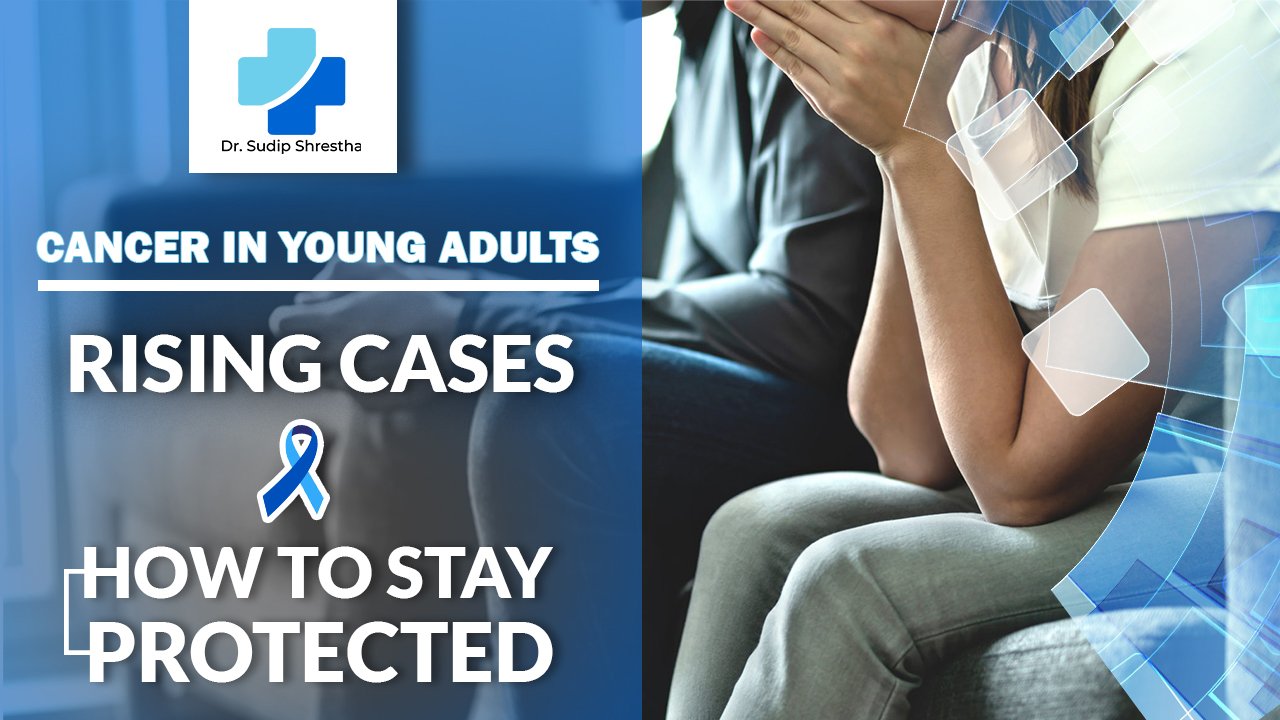Cancer is often associated with older adults, but in recent years, cancer in young adults (AYAs – Adolescents and Young Adults) has been increasing at an alarming rate. According to the National Cancer Institute (NCI), an estimated 84,100 AYAs (ages 15-39) will be diagnosed with cancer in the United States in 2024, accounting for approximately 4.2% of all cancer cases.
While survival rates have improved, the unique challenges faced by young adults with cancer—from late diagnosis to limited research on their specific cancer types—make awareness and prevention critical.
In this blog, Dr. Sudip Shrestha explores the rising trend of cancer in young adults, its causes, most common types, and how to stay protected.
Why is Cancer in Young Adults Increasing?
Several factors contribute to the increasing cancer rates in young adults, including lifestyle changes, environmental exposures, genetics, and late detection.
1. Lifestyle Factors
- Unhealthy Diet: Processed foods, sugary drinks, and low fruit/vegetable intake contribute to obesity and increase cancer risk.
- Lack of Physical Activity: A sedentary lifestyle raises the risk of various cancers, including colorectal and breast cancer.
- Smoking and Vaping: Tobacco and nicotine use increases the risk of lung, throat, and oral cancers.
- Alcohol Consumption: Excessive drinking is linked to liver, breast, and colorectal cancers.
2. Environmental Exposures
- Pollution and Toxins: Exposure to pesticides, air pollution, and industrial chemicals can trigger genetic mutations leading to cancer.
- Radiation Exposure: Frequent X-rays, CT scans, and UV radiation from excessive sun exposure can increase cancer risks.
3. Genetic and Hereditary Risks
- Family History: Individuals with a family history of breast, colon, or ovarian cancer have a higher risk.
- Gene Mutations: Inherited mutations like BRCA1 and BRCA2 increase the risk of breast and ovarian cancer.
4. Delayed Screenings and Diagnosis
Young adults often ignore symptoms or lack access to early cancer screenings. Unlike childhood or older adult cancers, there are fewer routine screening programs targeted at AYAs.
Most Common Cancers in Young Adults
Cancer types vary across age groups and gender. According to NCI’s Surveillance, Epidemiology, and End Results (SEER) Program, the most common cancers among AYAs (ages 15-39) include:
- Risk Factors: Family history, obesity, alcohol consumption, and late pregnancies.
- Symptoms: Lump in the breast, skin changes, nipple discharge.
- Risk Factors: Radiation exposure, genetic predisposition.
- Symptoms: Swelling in the neck, hoarseness, difficulty swallowing.
3. Testicular Cancer
- Risk Factors: Undescended testicles, family history.
- Symptoms: Lump/swelling in the testicle, heaviness in the scrotum.
4. Melanoma (Skin Cancer)
- Risk Factors: UV exposure (tanning beds, excessive sun exposure), fair skin.
- Symptoms: Unusual moles, changes in skin pigmentation.
5. Colorectal Cancer
- Risk Factors: Poor diet, smoking, obesity, inflammatory bowel disease (IBD).
- Symptoms: Blood in stool, persistent constipation/diarrhea, weight loss.
6. Lymphomas (Hodgkin’s and Non-Hodgkin’s)
- Risk Factors: Weakened immune system, Epstein-Barr virus (EBV).
- Symptoms: Swollen lymph nodes, night sweats, fatigue.
- Risk Factors: HPV infection, multiple sexual partners, smoking.
- Symptoms: Irregular bleeding, pelvic pain, painful urination.
How to Stay Protected: Cancer Prevention Tips
While some cancers are genetic, many lifestyle-related cancers can be prevented with proactive measures.
- Eat a balanced diet rich in fruits, vegetables, and whole grains.
- Avoid processed foods, red meat, and sugary drinks.
- Include antioxidant-rich foods (berries, nuts, leafy greens) to reduce oxidative stress.
2. Exercise Regularly
- Aim for at least 150 minutes of moderate exercise per week.
- Activities like jogging, swimming, cycling, and yoga help lower cancer risk.
3. Avoid Smoking and Limit Alcohol
- Tobacco use is responsible for one-third of all cancer deaths.
- Avoid e-cigarettes and vaping, which can cause lung-related cancers.
- Limit alcohol intake to reduce breast, liver, and colorectal cancer risks.
4. Protect Your Skin
- Use broad-spectrum SPF 30+ sunscreen daily.
- Avoid tanning beds and limit sun exposure during peak hours.
5. Get Vaccinated
- HPV Vaccine: Prevents cervical, anal, and throat cancers caused by the HPV virus.
- Hepatitis B Vaccine: Protects against liver cancer.
6. Know Your Family History
- If you have a history of breast, colon, or ovarian cancer, consult a genetic counselor.
- Consider early screenings and preventive measures if you are high-risk.
7. Regular Screenings and Check-Ups
- Pap Smear (Women 21+): Every 3 years to detect cervical cancer.
- Mammograms (Women 30+ if high-risk): For early breast cancer detection.
- Colonoscopy (30+ if high-risk): Screening for colorectal cancer.
- Skin Check (All Ages): Monitor moles and skin changes for melanoma.
8. Listen to Your Body
- Unusual symptoms like persistent pain, weight loss, or lumps should not be ignored.
- Early detection dramatically improves survival rates.
Conclusion
The rising cases of cancer in young adults highlight the need for awareness, early detection, and proactive lifestyle choices. While some factors like genetics are beyond our control, preventative measures such as a healthy diet, regular exercise, and routine screenings can significantly reduce cancer risk.
Dr. Sudip Shrestha encourages young adults to stay informed, prioritize their health, and take preventive steps today to ensure a healthier future.



